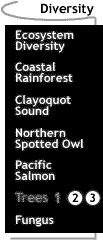

  |
Diversity: Trees Types of Forests in British Columbia The diverse nature of British Columbia's (BC) topography and climate supports a wide variety of vegetation. Twelve different types of forest grow in BC.
So How Big Are Those Old Growth Trees Anyway? If you have never seen old-growth trees, you may have a difficult time visualizing just how big they are. Even this historic photo of an old-growth tree may not help. The activities below should give you a new perspective on the enormous size of these trees. These activities should provide an awareness of why these trees, containing thousands of board feet of lumber, are so important to the logging industry. Activities
Now, consider the circumference. Could a cross-sectional piece of an old-growth tree fit
Do any of these trees have a diameter wider than a school bus? Is the whale really the largest living thing on Earth?
Data adapted from Olympic National Park Field Guide; The National Park Service; and Redwood National & State Parks Get a 100-foot or 50-meter measuring tape, and using numbers from Table 1, mark off on your school grounds an area equal in circumference to one of the old-growth trees. Perhaps masking tape could be used on the classroom floor for this purpose. You might use sticks or poles of some kind on a football field or baseball court to mark off the tree's height. Activity 2 Take a walk around your neighborhood, find the tallest tree, and measure its height. Lumber companies and forestry agencies use special equipment such as clinometers, altimeters, or hysometers to measure the heights of standing trees. It is possible, however, to estimate (with a high degree of accuracy) the height of a tree without expensive equipment. The method of measuring the height of a tree described below is taken from a 1948 Handbook for Boys published by the Boy Scouts of America. Although this method requires no special equipment, you will need a partner, a marker, and a tall pole, perhaps a broom or lawn rake.
Considering that most of the homes in that neighborhood were built in the early 1900s, it would be safe to say that it has taken this maple tree approximately 90 years to reach its current stature. How does it compare in height, circumference, and age to that of old-growth trees? Download TIFF on to your hard drive and open it in NIH Image. NIH Image has a wide selection of measurement options, but before you actually begin making measurements, you will need to: set the scale of the image, and then select the measurement options you want to use. (If you have forgotten how to set scale or make linear measurements, visit beautiful Honolulu and refresh your memory!) Use the young man standing along side the tree as a scale. He is 6 feet tall. To measure the height of the tree, place the cursor at the bottom of the tree. While clicking and holding down the mouse button, drag the cursor to the top of the tree, and release the mouse button. The line of "marching ants" will appear between the starting and ending points. Select Analyze/Measure and then Analyze/Show Results. A data window will appear showing your distance measurement. You can also use this image to determine the number of board feet contained in this tree. Again using the young man as a scale, measure the diameter of the tree at breast height, and follow the procedure in Activity 3, below. If you have access to a scanner, you may want to take a photograph of the tallest tree in your neighborhood to use in this activity. Remember to include someone or something of known height in the picture as a scale reference. What Is The Economic Value Of An Old-Growth
Tree? Activity 3 Now, refer to either of the tables at the Ohio State University Extension web site to find the gross number of board feet contained in a given tree. Information in their web site indicates that the International 1/4-inch rule (Table 2) is used by the U.S. Forest Service and more accurately estimates the yield of lumber than does the Doyle rule (Table 1). [ Diversity: Ecosystem Diversity / Coastal Rainforest / [ Ecosystem Flexibility ] [ Natural & Human Disturbance ] [ Logging ] [ Home ] [ Teacher Pages ] [ Modules & Activities ] |
|||||||||||||||||||||||||||||||||||||||||||||||||||||||||
HTML code by Chris Kreger
Maintained by ETE Team
Last updated November 10, 2004
Some images © 2004 www.clipart.com
Privacy Statement and Copyright © 1997-2004 by Wheeling Jesuit University/NASA-supported Classroom of the Future. All rights reserved.
Center for Educational Technologies, Circuit Board/Apple graphic logo, and COTF Classroom of the Future logo are registered trademarks of Wheeling Jesuit University.